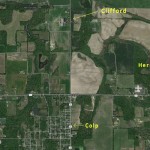Clifford, a village along the line between sections 14 and 15, Blairsville Township, was named for Clifford Garrison. O. L. Garrison, his father, was president of the Big Muddy Coal and Iron Company. This organization was an outgrowth of one of the first mining companies in Jackson County, and operated iron furnaces at Grand Tower on the Mississippi river. They opened a mine at Fredonia during the early days of Williamson county coal operations. Ethan Allen Hitchcock, ambassador to Russia and secretary of the interior in President McKinley’s cabinet, was a partner in the firm.
 Big Muddy began their preparatory work at Clifford in 1902. The shaft was sunk just southwest of the center of section 14. They struck coal November 27, 1903, and the first coal was hoisted before the year was out. In 1906 and 1907, the Illinois Central railroad extended their Madison 9 lead from Colp and Brush junction to Clifford in order to serve Big Muddy mine 8.
Big Muddy began their preparatory work at Clifford in 1902. The shaft was sunk just southwest of the center of section 14. They struck coal November 27, 1903, and the first coal was hoisted before the year was out. In 1906 and 1907, the Illinois Central railroad extended their Madison 9 lead from Colp and Brush junction to Clifford in order to serve Big Muddy mine 8.
A town for the miners was built by the company, and a post office secured June 26, 1905. Patrick H. Carroll was the first postmaster, succeeded by E. A. Kilbreth in 1910. Allen Kilbreth went to school near his father’s farm at Wolf Creek, and at Clifford was president of the school board. Harry Erwin and John Cox served as postmasters between 1930 and May 15, 1935 when the office was discontinued.
One of the picturesque figures of Clifford was Jim R. Corder (1864-1938). He operated the air compressors, looked after the mine mules, and enjoyed himself with high-bred horses. Mr. Corder was a descendant of Lewis Corder, Revolutionary veteran, early settler in Crab Orchard, and charter member of Coal Bank, church.
The Consolidated coal company of St. Louis bought Clifford mine with other Big Muddy property in 1920. Consolidated mine number 8 is now idle.
William Shannon, present treasurer of the county (in 1939), was a Clifford resident at the time of his election, November 8, 1938. He worked there as mine boss.
(Extracted from Pioneer Folks and Places, Barbara Barr Hubbs, 1939, on sale at the Williamson County Museum)
